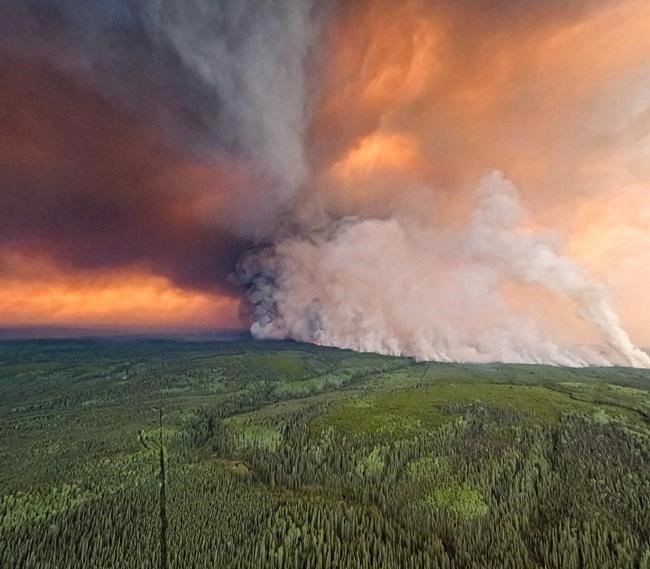VANCOUVER — All campfires across British Columbia were banned Monday, except on the North Coast island of Haida Gwaii, after thousands of lightning strikes and worsening drought conditions resulted in more than 100 new wildfires over the weekend.
Bowinn Ma, minister of emergency management and climate readiness, said the ban applies to the smallest category 1 campfires, measuring up to 50 centimetres by 50 centimetres, expanding prohibitions already applied to certain regions in B.C. or to larger fires.
"Things have certainly escalated very drastically in a large part of the province over the weekend," Ma said at a news conference on Monday.
"In the last three days, there have been more than 23,000 lightning strikes in total. This lightning activity is compounded by ongoing drought conditions and high temperatures."
She said 115 fires were sparked by dry lightning over the weekend, with 311 fires burning across the province.
"We are anticipating continued extreme fire behaviour," Ma said.
She said 11,500 square kilometres of land had been burned this season. That puts 2023 on track to surpass a record set in 2018 when 13,543 square kilometres burned.
She said 156 people were under evacuation orders across B.C., and 629 under evacuation alert to leave their homes at short notice in the northwest, northeast and Cariboo region in the Interior.
Ma also declared a state of emergency for the Stikine Region in the province's northwest, effective immediately, to allow wildfire evacuations in the unincorporated region.
"In effect, we are acting as the local government in that area," she said.
The state of emergency would initially be in place for 14 days, but could be rescinded or extended, said a ministry statement.
Cliff Chapman, BC Wildfire Service spokesman, said the wildfire situation had worsened over the weekend and conditions have officials concerned about the likelihood of more fires.
B.C. was "tight on resources" to fight the big surge in wildfires, said Chapman, speaking at the Â鶹´«Ã½Ó³»news conference from Kamloops.
He said 160 firefighters from Mexico and the United States were in B.C. helping battle fires in the province's hard-hit northeast, with another 100 firefighters from Mexico expected next week.
The category 1 campfire ban was needed to reduce the risk of human-caused wildfires, Chapman said.
"We cannot afford to have a preventable fire occur in the province," he said. "We are asking the globe for help. We cannot afford to have human-caused fires in B.C."
Chapman said the presence of the foreign firefighters across Canada has been a welcome and unique reaction to a difficult situation.
"We're really seeing a global response to what's happening across Canada this year," he said. "We're activating countries that have never really supported Canadian fires in the past."
Chapman said in addition to Mexican and American firefighters in B.C., there are 100 South Korean firefighters in Quebec and firefighters from France and the Dominican Republic are in the eastern provinces.
Firefighters from South Africa have been in Alberta.
Ma said she expects to provide an update on B.C.'s drought level later this week.
"The drought situation is serious," she said. "We have not experienced this level of drought across the province this early in the year in recent memory. Many communities are implementing water restrictions already. We anticipate the need to escalate those water restrictions in larger areas of the province."
The Emergency Management Ministry said low rainfall and other precipitation over the past year had seen drought conditions worsen in B.C., with most water basins now at level four, on a five-level drought scale. Level-four drought involves extremely dry conditions, with adverse effects of socioeconomic conditions and ecosystems likely.
Before Monday's announcement, the Cariboo and Kamloops fire centres in B.C.'s Interior and the Prince George fire centre in the northeast had already imposed bans on category 1 campfires.
Almost 200 of the 311 fires burning across B.C. are rated as out of control.
Of the 13 blazes listed as "fires of note," all but two are located in the Prince George and Northwest fire centres, and 12 have prompted at least one evacuation order, although no major communities are threatened.
Some of the fires are threatening rural highways, including Highway 27 south of Fort St. James and Highway 77 north of Fort Nelson, while flames first spotted last Thursday near the Yukon boundary now cover 300 square kilometres close to Highway 37, but aren't immediately affecting the link to Watson Lake and Whitehorse.
A wildfire in Yukon has roughly tripled in size since Sunday and remains out of control. Charring about three square kilometres of bush in the Ibex Valley, about 30 kilometres due west of Whitehorse, south of the Alaska Highway, it prompted an evacuation alert for numerous properties along the route.
B.C.'s wildfire danger was high to extreme across all but small pockets of the province Monday.
Environment Canada posted a severe thunderstorm watch for the Fort Nelson and Peace River regions, the same area where large fires forced evacuations in July.
The weather office noted daily high temperature records were set in the province Sunday, including a high of 33 C in Fort Nelson, two degrees hotter than the previous record for that northeastern community, set 64 years ago.
Forecasters said Nakusp in B.C.'s southeast also posted a sizzling 37.2 C on Sunday, edging its old mark set 22 years earlier, and while no daily highs were posted in Yukon, that territory remains under heat warnings stretching almost 500 kilometres from its boundaries with B.C. and the Northwest Territories north to Mayo.
Conditions could ease slightly in B.C. by Tuesday, but Environment Canada said cooler weather was not likely in Yukon for several more days.
This report by The Canadian Press was first published July 10, 2023.
Dirk Meissner, The Canadian Press



